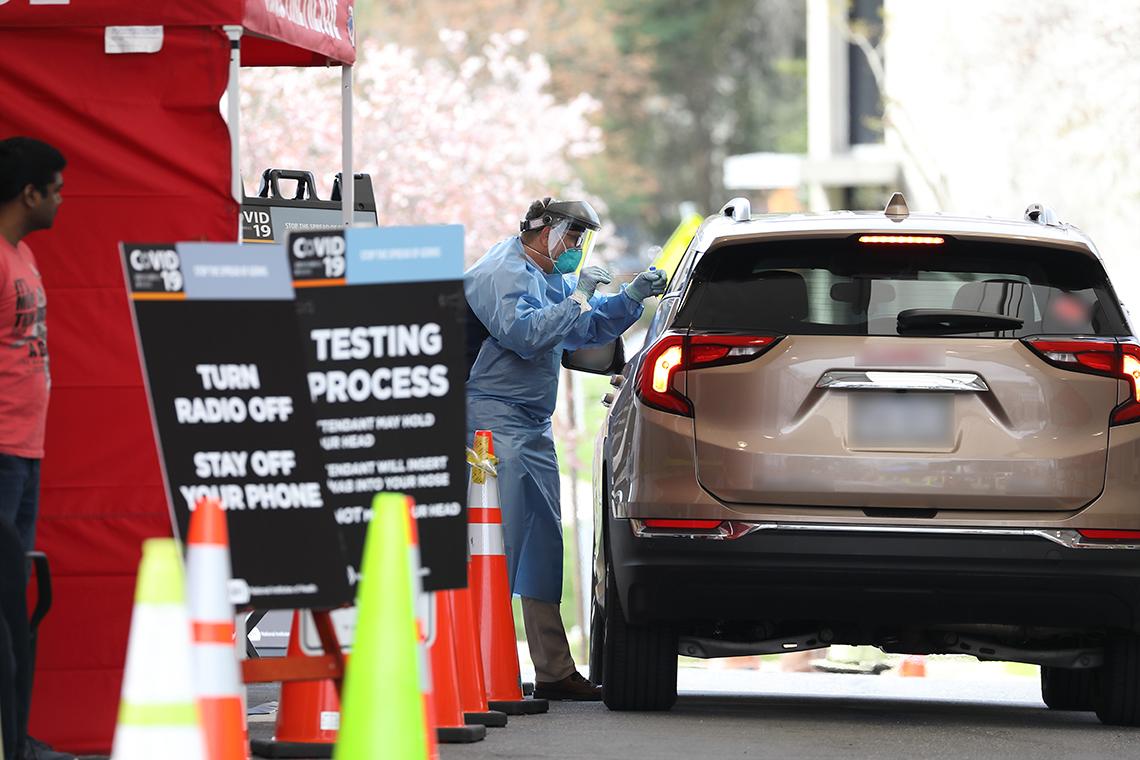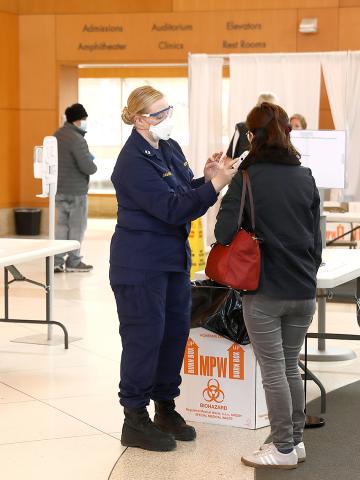NIAMS Staffers Look Back on Pandemic Volunteer Efforts

In January 2020, news of a novel coronavirus spreading through China caught the world’s attention and we watched as cases emerged across the globe. Most of us did not expect that, 2 months later, we would face rapidly increasing infection rates and a lockdown that would make 2020 a year we won’t soon forget.
Covid-19 hit the NIH campus on Mar. 15, 2020, when a staff member tested positive for the disease. NIAMS clinical staff immediately sprang into action and volunteered with screening and testing efforts to mitigate spread of the virus. Nearly 2 years later, NIAMS staff who supported response efforts at NIH and surrounding communities, reflect.
Research Nurse, Dedicated Volunteer
The desire to help others is ingrained in the DNA of research nurse April Brundidge who has a long history of volunteerism. Despite the fear that gripped everyone at the start of the pandemic, she was among the first to assist with testing NIH staff. Brundidge noted the importance of faith in helping her get through the experience, “I would just sit in my car and pray, ‘Please allow me to help these people and watch over me.’”
In the beginning, testing stations were set up in an outdoor pavilion near Lister Hill. For Brundidge, dealing with the weather—the sweltering heat of summer and the blistering cold of winter—was one of the biggest challenges. Volunteers made the most of the situation by joking or jumping around and using hand warmers to ward off the chill. Eventually, testing moved indoors.
NIH staff and community members were eager to show appreciation for the volunteers. Hand-knitted scarves, doughnuts and posters with words of encouragement were just a few tokens of gratitude received by the team. “The community’s generosity and kindness will be a happy memory,” said Brundidge.
Nurse Practitioner, Fighter of Disparities

As a nurse practitioner and commander in the PHS Commissioned Corps, Alice Fike had previous experience on the frontlines of outbreaks, including the 2014 Ebola crisis in Africa. Fike was one of the first NIAMS staffers to assist with Covid-19 screening at the Clinical Center and was later assigned to the vaccination clinic.
It was natural for Fike to remember her experience with the Ebola vaccine trial in Liberia. She noticed a striking similarity between each nation’s willingness to participate in clinical trials for new treatments to fight infectious disease.
The Covid-19 pandemic shined a spotlight on health care disparities. Individuals in underserved communities faced increased risk of contracting Covid-19 and difficulties accessing screening and vaccination sites. Fike helps address some of these disparities through her work in the NIAMS Community Health Clinic, where she sees minority and foreign-born patients affected by rheumatic diseases. “I’m doing my part by answering patients’ questions and helping them navigate how to get a vaccine,” Fike said. “That’s a small thing, but a very meaningful thing.”
Postbac, EMT
Madie Alexander started her postbac training in translational immunology last July, in the middle of the lockdown. As it did with other trainees, Covid-19 forced her to swap precious lab hours for virtual training and online meetings. But it also provided a unique opportunity to join the fight against a global pandemic. A licensed emergency medical technician, Alexander wanted to use her training to contribute to the pandemic response. She signed up to volunteer with Medical Reserve Corps in Washington, D.C.
Alexander aspires to be a physician and plans to enroll in medical school after completing her NIH training. “It hasn’t been the ‘classic’ NIH experience,” she noted, “but it has been meaningful in many ways that are important for my growth. It’s also very exciting to be at the NIH when it matters more than ever before.”
Postbac, Maker of Masks

After graduating from Colorado College in May 2020, Hugh Alessi was enthusiastic to come to NIAMS as a trainee studying vasculitis. Covid-19 restrictions forced him to delay his move to Bethesda. While waiting in Colorado to learn when new trainees would be permitted to work on campus, Alessi joined friends on a hunt for sewing machines. The group sewed hundreds of masks and distributed them to emergency workers in Colorado Springs during the height of the mask shortage. After moving to the D.C. Metro area, Alessi immediately signed up to volunteer with the Maryland Medical Reserve Corps.
“I felt somewhat of a duty to get involved,” stated Alessi, who hopes to attend medical school next year. “I was exceedingly excited to help others and give back to my new community.”
Looking back, Alessi highlighted that trust was critical for success at screening and vaccination clinics. From patients trusting volunteers to calm their fears and effectively answer questions, to volunteers trusting patients to keep their masks on, the community must rely on each other to fight Covid-19.
Scientific Director, Vaccinator
After learning a NIAMS staff member was the first NIH’er to contract Covid-19, NIAMS scientific director Dr. John O’Shea felt the need to spring into action quickly. The initial priority was ensuring the safety of other staff. Next, he had to focus on how to keep labs functioning during the lockdown. He then volunteered to chair an online platform to submit ideas for tools and strategies to mitigate the disease. After he lost his mother to Covid-19 last spring, O’Shea’s desire to volunteer became more personal. He decided to serve the community by helping with vaccinations.
Since becoming scientific director 15 years ago, O’Shea had not been directly involved with patient care—especially not giving shots. “I thought if I really want to get good at vaccinating, I should work with a nurse or a pediatrician,” O’Shea quipped. After training with both a nurse and a pediatrician for a few days, he began administering vaccines at NIH and Montgomery County clinics.
“It was a joyous experience,” he recalled, noting a sense of optimism after a year of pandemic-related challenges. “Working with a group of volunteers from so many different backgrounds, who all recognized the importance of the situation and just wanted to do their part to help, it was truly inspiring.”
In This Together
It has been 22 months since Covid-19 impacted all our lives. What started as a somber period of uncertainty has transitioned to hopeful signs that we are turning the tide. Though we are not yet at the finish line, none of this progress would be possible without the scientists who raced to develop vaccines, the teams who delivered them, and the many stalwart volunteers whose work supported every step of the response.
The continuing pandemic is affecting everyone differently. Everyone will have unique memories to share from this period. But the stories of volunteers highlight the importance of community during a time of crisis.
“Everyone working together as a team to fight this virus helped restore our sense of community,” said Alessi, “Covid reminded us that we’re all in this together.”
